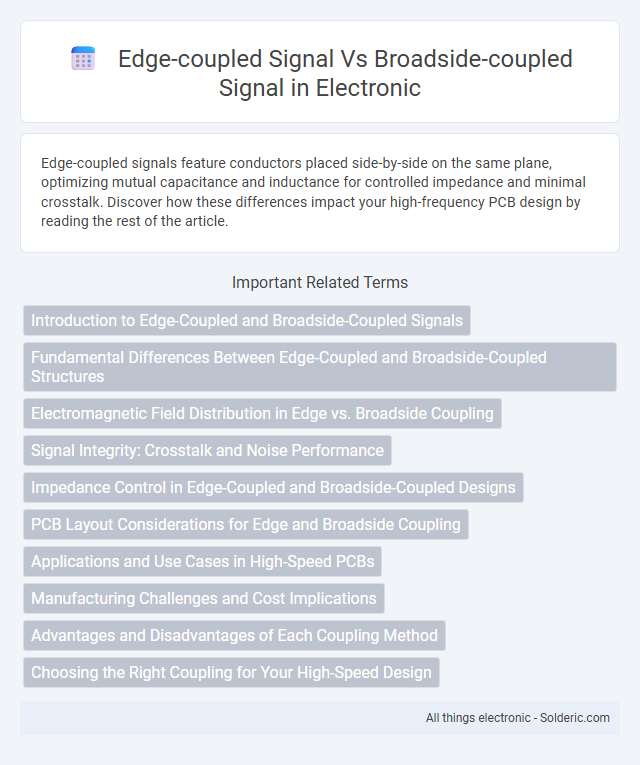Edge-coupled signals feature conductors placed side-by-side on the same plane, optimizing mutual capacitance and inductance for controlled impedance and minimal crosstalk. Discover how these differences impact your high-frequency PCB design by reading the rest of the article.
Comparison Table
| Feature | Edge-Coupled Signal | Broadside-Coupled Signal |
|---|---|---|
| Coupling Mechanism | Side-by-side conductor arrangement | Conductors stacked vertically |
| Coupling Strength | Moderate coupling | Stronger coupling |
| Signal Integrity | Good, less capacitive coupling | Improved impedance control, higher capacitance |
| Manufacturing Complexity | Simple, uses standard PCB layers | Complex, requires multilayer PCB stacking |
| Typical Applications | High-speed differential pairs, controlled impedance lines | Filters, couplers, and tight impedance control scenarios |
| Impedance Characteristics | Higher odd-mode impedance | Lower odd-mode impedance |
| Space Efficiency | Requires more lateral PCB area | Better space utilization vertically |
Introduction to Edge-Coupled and Broadside-Coupled Signals
Edge-coupled signals involve two transmission lines placed side-by-side, enabling electromagnetic coupling primarily through adjacent edges, which is ideal for differential signaling and controlling impedance. Broadside-coupled signals consist of two conductors aligned one above the other with a dielectric separating them, enhancing capacitive coupling and providing tighter control over coupling coefficients and crosstalk reduction. These coupling configurations fundamentally influence signal integrity, propagation delay, and electromagnetic interference in high-speed PCB and IC design.
Fundamental Differences Between Edge-Coupled and Broadside-Coupled Structures
Edge-coupled signals have conductors placed side-by-side on the same plane, offering strong electric field coupling and easier fabrication for differential signaling, while broadside-coupled signals feature conductors stacked vertically on adjacent layers, providing higher coupling capacitance and improved isolation. The edge-coupled structure typically exhibits lower parasitic capacitance and is commonly used in high-speed data transmission, whereas broadside coupling achieves better phase velocity matching and reduced crosstalk for controlled impedance environments. Understanding these fundamental differences helps you optimize signal integrity and electromagnetic compatibility in high-frequency circuit designs.
Electromagnetic Field Distribution in Edge vs. Broadside Coupling
Electromagnetic field distribution in edge-coupled signals primarily concentrates the electric and magnetic fields at the edges of adjacent conductors, resulting in strong fringing fields and tighter coupling control. In broadside-coupled signals, the fields are distributed across the facing broad surfaces of the conductors, producing a more uniform and stronger capacitive coupling with reduced radiation loss. This difference leads to edge coupling favoring narrower spacing for high coupling, while broadside coupling offers enhanced shielding and lower dispersion in high-frequency circuits.
Signal Integrity: Crosstalk and Noise Performance
Edge-coupled signals typically exhibit lower crosstalk due to the reduced coupling area between adjacent traces, enhancing signal integrity in high-speed PCB designs. In contrast, broadside-coupled signals have increased mutual capacitance and inductive coupling, often resulting in higher noise susceptibility and degraded signal quality. Optimizing trace spacing and dielectric properties is crucial in both configurations to minimize interference and maintain robust signal performance.
Impedance Control in Edge-Coupled and Broadside-Coupled Designs
Impedance control in edge-coupled designs relies on the spacing between adjacent microstrip lines, which primarily influences characteristic impedance and coupling strength through lateral separation. Broadside-coupled designs achieve impedance control by stacking conductors vertically, allowing tighter coupling and more compact layout with greater precision in differential impedance matching. You can optimize signal integrity by selecting edge-coupled structures for simpler planar integration or broadside-coupled layouts when stringent impedance and coupling uniformity are critical.
PCB Layout Considerations for Edge and Broadside Coupling
Edge-coupled signals require precise spacing between adjacent traces on the PCB to control impedance and minimize crosstalk, often benefiting from symmetric differential pair routing. Broadside-coupled signals involve stacking traces on different layers with dielectric separation, demanding careful consideration of layer thickness and dielectric constant to maintain signal integrity and impedance matching. Your PCB layout must optimize trace width, spacing, and layer stackup to ensure reliable high-speed differential signaling in both edge and broadside coupling configurations.
Applications and Use Cases in High-Speed PCBs
Edge-coupled signals are widely used in differential pairs for high-speed PCB designs where tight impedance control and minimal crosstalk are essential, such as in PCIe and USB 3.0 interfaces. Broadside-coupled signals offer higher coupling capacitance and are preferred in applications requiring improved noise immunity and reduced electromagnetic interference (EMI), like in radar systems and high-frequency RF circuits. Both coupling methods optimize signal integrity but are selected based on specific performance needs in controlled impedance and signal crosstalk environments within high-speed communication protocols.
Manufacturing Challenges and Cost Implications
Edge-coupled signals involve placing conductors side-by-side, which simplifies manufacturing by requiring less precise alignment and reducing layer stacking complexity, resulting in lower production costs. Broadside-coupled signals, with conductors stacked vertically, demand stricter layer registration and increased dielectric control, leading to higher manufacturing challenges and increased costs. Your choice impacts fabrication complexity and budget, as edge coupling is typically more cost-effective for high-volume production runs.
Advantages and Disadvantages of Each Coupling Method
Edge-coupled signals offer lower crosstalk and easier impedance control, making them suitable for high-speed differential pairs, but they require more PCB area and can suffer from asymmetrical coupling. Broadside-coupled signals provide stronger coupling and better noise immunity due to their parallel face-to-face conductor arrangement, though they are more complex to manufacture and can have increased parasitic capacitance. Choosing between these methods depends on design priorities such as space constraints, signal integrity, and manufacturing capabilities.
Choosing the Right Coupling for Your High-Speed Design
Edge-coupled signals offer tighter coupling and better isolation, making them ideal for differential pairs in high-speed PCBs where signal integrity and crosstalk minimization are critical. Broadside-coupled signals provide higher capacitance and can be useful in achieving specific impedance targets or tighter spacing in multilayer designs. Understanding the trade-offs between edge and broadside coupling allows you to optimize signal integrity, impedance control, and electromagnetic interference in your high-speed design.
edge-coupled signal vs broadside-coupled signal Infographic

 solderic.com
solderic.com